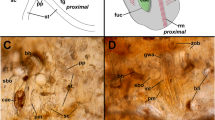Abstract
To address the functional contributions of capillary chaetae in the maldanid polychaete Clymenella torquata, we compared irrigation efficiency and tube structure for animals with intact and trimmed capillary chaetae. We measured pumping rates for worms before and after they were anaesthetized and subjected either to capillary trimming or mock trimming, i.e. handling without trimming. Worms with trimmed chaetae were significantly less effective at moving water through their tubes than those with intact chaetae. There were no significant differences in the ability of control worms to move water within their tubes. No significant changes in rates of peristalsis were observed among experimental or control groups. These data strongly suggest that body musculature and capillary chaetae work in concert to hold worms in position within tubes during peristaltic pumping. When chaetae are shortened, the body musculature must contract to a greater degree, increasing the functional diameter of the worm to achieve the necessary traction with the tube wall, resulting in less efficient irrigation. We also compared the inner diameters of original field tubes to tubes built by control worms or worms after capillary trimming. The inner diameters of new tubes built by worms with shortened chaetae were larger than their original tubes, while those of both control groups were not. One possible explanation is that the chaetae have a sensory role and shortened chaetae send the false message that the nascent tube walls are farther away than they are, the body contracts in compensation and the tube is widened, however this idea has not been tested.
Similar content being viewed by others
References
Fauchald, K. & G. W. Rouse, 1997. Polychaete systematics: Past and present. Zool. Scr. 26: 71–138.
Knight-Jones, P. & M. R. Fordy, 1979. Setal structure, function, and interrelationships in Spirorbidae (Polychaeta, Sedentaria). Zool. Scr. 8: 119–138.
Knight-Jones, P., 1981. Behaviour, setal inversion and phylogeny of Sabellida (Polychaeta). Zool. Scr. 10: 183–202.
Merz, R. A. & D. R. Edwards, 1998. Jointed setae – their role in locomotion and gait transitions in polychaete worms. J. exp. mar. Biol. Ecol. 228: 273–290.
Merz, R. A. & S. A. Woodin, 2000. Hooked setae: tests of the anchor hypothesis. Invertebrate Biol. 119: 76–82.
Merz, R. A. & S. A. Woodin, 1991. Resistance to bending of capillary setae from sedentariate polychaetes. Ophelia Suppl. 5: 615–623.
Mettam, C., 1971. Functional design and evolutionn of the polychaete Aphrodite aculeata. J. Zool., Lond. 163: 489–514.
Mettam, C., 1984. Functional morphology of locomotion in Chloeia (Polychaeta; Amphinomidae). In Huchings, P. A. (ed.), Proc. First Internat. Polychaete Conf., Linnean Soc. New SouthWales, Sydney: 390–400.
Rouse, G. W. & K. Fauchald, 1997. Cladistics and polychaetes. Zool. Scr. 26: 139–204.
Roy, P. A., 1974. Tube dwelling behavior in the marine annelid Phragmatopoma californica (Fewkew) (Polychaeta, Sabellariidae). Bull. Sth. Calif. Acad. Sci. 73: 117–125.
Trueman, E. R., 1975. The Locomotion of Soft-Bodied Animals. American Elsevier Publishing Company, Inc. New York. 200 pp.
Woodin, S. A. & R. A. Merz, 1987. Holding on by their hooks: anchors for worms. Evolution 41: 427–432.
Author information
Authors and Affiliations
Rights and permissions
About this article
Cite this article
Woodin, S.A., Merz, R.A., Thomas, F.M. et al. Chaetae and mechanical function: tools no Metazoan class should be without. Hydrobiologia 496, 253–258 (2003). https://doi.org/10.1023/A:1026157217821
Issue Date:
DOI: https://doi.org/10.1023/A:1026157217821




